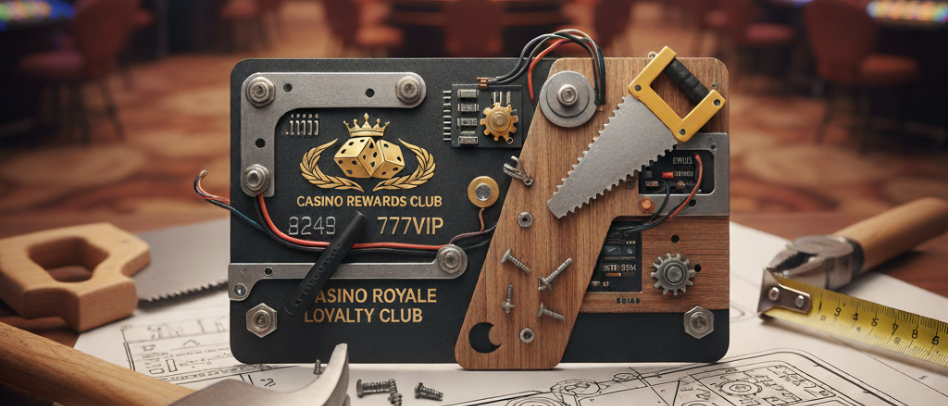TL;DR (Too Long; Didn’t Read):
A great casino players club isn’t built by copying the competition—it’s designed with intention.
Start by anchoring your tiers in brand identity, not color schemes.
Keep the program simple, aspirational, and mathematically sound by designing around reinvestment, not expense.
Finally, train every team member—from front line to back office—to deliver a consistent, branded guest experience.
Most players clubs underperform—not because their operators lack commitment, but because they copy competitor tiers, hard-wire the wrong benefits into the structure, and never ask their players what matters.
If you’ve been tasked with building or rebuilding your players club, you’re facing some tough questions: How many tiers should we have? What benefits belong in the club versus the mailbox? How do we create aspiration without creating confusion? And most importantly, how do we build a program that drives repeat visits and measurable revenue, not just cards in wallets?
In a previous article, we explored how to reframe your casino loyalty program as a brand-level experience rather than just a points-and-perks engine. Now, let’s roll up our sleeves and walk through exactly how to architect (or rebuild) a players club that delivers on that promise—step by practical step.
The Players Club Blueprint: 8 Steps from Foundation to Launch
Step 1: Start with Your Brand Promise (Before You Name a Single Tier)
Players clubs cannot (or should not) be created in a vacuum, separate from their brand identity. The result? Your players club isn’t just one program among many. It’s the most pervasive element of your guest experience, touching more people more often than any other aspect of your operation, and representing one of the most significant influences on guest behavior and profitability. That makes a clearly articulated brand purpose non-negotiable. Your program needs to be integral to who you are rather than seemingly bolted on.
Your players club should be the most visible expression of your brand promise—the living proof that you deliver on what you advertise. That means you need to start with your Brand Ladder before you design a single tier or benefit.
Quick Brand Ladder Exercise:
Write one sentence for each level:
- Values: What we stand for (e.g., “neighbors serving neighbors,” “local pride,” “genuine hospitality”)
- Attributes: What guests reliably experience (e.g., “warm service,” “easy access,” “first-to-play new games”)
- Functional Benefits: The tangible perks (priority seating, parking, comp dollars, exclusive invites)
- Emotional Payoff: How they feel (e.g., “I’m recognized,” “I belong here,” “I matter”)
This ladder becomes your filter. Every club benefit, every tier name, every communication should reinforce this promise. If a perk doesn’t support your brand position, it doesn’t make the cut—no matter how “standard” it seems.
When your club is built on your brand, not borrowed from competitors, you create emotional preference that transcends promotional wars. Players choose you even when your offers aren’t the biggest.
Step 2: Design Your Tier Architecture with Aspiration. Then Stop.
I often see properties design five or six tiers because larger casinos have them, without considering whether their local market needs that level of complexity or how they can differentiate the tier experience within the limitations of their facility.
For most regional properties, 2-4 tiers are plenty. What matters more than the number of tiers is the distance between them—the clear, achievable rungs your players can see and chase.
The Psychology Behind Tier Aspiration:
Research shows that tier status is especially motivating for lower-worth and mid-worth players. They’re more likely to modify behavior to reach the next level than your high-worth guests (who may already be at the top). That means you need:
- Visible gaps: Each tier must feel meaningfully different from the one below it
- Reachable goals: Progress bars and “you’re this close” nudges (goal-gradient effect)
- Starter momentum: Endow new members with partial progress toward their first milestone (endowed progress effect)
- Loss aversion tools: Grace periods with “save your status this week” messaging
Example Tier Architecture (3 Tiers):
| Tier | Earn Requirement | Clear Aspiration Gap | Psychological Nudges |
| Core | Signup | Auto-qualify | Endowed with 100 points toward the next tier; “You’re already 20% there!” |
| Preferred | 500 points/quarter | 2x the entry threshold | Progress bar; monthly “Boost your status” double-point days; 30-day grace period |
| Elite | 2,000 points/quarter | 4x the mid-tier | Quarterly status check-in from host; 60-day grace period; invitation to preview |
Don’t add tiers just to appear sophisticated. If players can’t feel the difference between levels, you’ve diluted aspiration rather than created it.
Step 3: Separate Club Entitlements from Mailbox Levers
When benefits that should live in the mailbox (or app) are hard-wired to the club, properties can get stuck, locked into promotional strategies they can’t adjust without reprinting everything and retraining everyone.
Here’s the principle: The club should provide identity and access. The mailbox should provide variable value and incentives.
Keep in the Club (stable, brand-true entitlements):
- Tier recognition and status identity
- Priority access (line-skips, preferred parking, early entry to events)
- Service levels (dedicated hosts, faster service guarantees)
- Access experiences (members-only events, behind-the-scenes tours, previews)
Keep in Mailbox/App (adjustable by segment and season):
- Free play and bonus dollars
- Dining and hotel credits
- Point multipliers and accelerators
- Trip-builder bonuses and streak rewards
- Targeted promotional campaigns
Why this split matters: You protect your brand promise and tier structure while maintaining flexibility to right-size your reinvestment by segment, test offers, and respond to competitive pressure—all without touching your foundational program.
Step 4: Build the Economics on Reinvestment, Not Expense
Too many properties design their club by asking, “What did we spend last year?” or “What can we afford?” instead of starting with theoretical win and working backward to optimal reinvestment levels.
The Reinvestment Mindset:
Your players club isn’t a cost center. It’s a reinvestment vehicle that should drive incremental trips and theoretical win. That means designing from basic casino math rather than a P&L.
Core Math (simple and transparent for your team):
- ADT (per player) × Trips × Hold % = Theoretical Win
- Reinvestment % target by tier/segment → guides both club entitlements and mailbox offers
- Track incremental trips per offer, not just redemption rates
Example Focus by Tier:
| Segment | Focus |
| High-worth, high-frequency | Retention; VIP experiences |
| Mid-worth, frequency-builders | Trip incentives; progression nudges |
| Low-worth, aspirational | Engagement; tier-climb rewards |
Create a monthly KPI review (see Step 7) where you track actual reinvestment against targets. If a benefit or offer isn’t moving trips or ADT, sunset it and test something new.
This shift in thinking—from expense to reinvestment—changes everything. It turns your club into a strategic tool rather than a budget line item.
Step 5: Ask Players First (Before You Lock Anything)
Your best insurance against copycat clubs and internal bias is qualitative research—actually talking to your players before you design the program.
Essential Research Steps:
Focus Groups (5-8 sessions across all tiers):
- What do they value most about coming here vs. competitors?
- What would make them visit more often?
- What tier benefits would they actually use?
- What club names/language resonate vs. feel generic?
Competitor Mystery Shops (3-5 programs):
- What are competitors promising and delivering?
- Where are the gaps you can exploit?
- What’s being over-promised and under-delivered?
On-Floor Intercepts (uncarded visitors):
- Why haven’t they joined?
- What would motivate them to sign up?
- What misconceptions exist about club membership?
Bake this into your foundation phase, then design tiers and benefits around what you learn. This step alone will differentiate your club from the “we copied theirs” approach some properties take.
Research-backed recommendations get approved faster than gut-feel proposals.
Step 6: Convert Uncarded to Carded with Low-Friction Psychology
Uncarded players represent your most significant missed opportunity—revenue walking through your doors that you can’t track, target, or optimize. Yet many properties treat signup as a checkbox compliance exercise rather than a conversion-optimized experience.
Psychological Principles for Higher Signup Rates:
- Immediate gratification: Give them something now (instant bonus, free drink, line-skip pass)
- Foot-in-the-door: Make the first commitment tiny (“just scan your ID”), then escalate
- Emotional frame: Lead with status and access (“Join our VIP club”), not tracking (“Get your card so we can monitor you”)
- Social proof: Train staff to say, “Most of our regulars love the club because…” (not “Would you like to sign up?”)
- Reduced friction: Make signup fast—under 2 minutes, mobile-friendly, minimal fields
Sample Talk Track for Floor Staff:
“Welcome! Have you been here before? Great! Are you part of our [Club Name] yet? It’s free, and you’ll get [instant benefit] today, plus [ongoing benefit]. It takes about a minute. I can help you right now.”
Not: “Do you have a player’s card?” (This sounds transactional and assumes rejection.)
Train your entire team on this approach—not just hosts, but security, slots, F&B, cage, EVS, and hotel. Every touchpoint is a potential conversion opportunity.
Step 7: Run a Weekly KPI Scoreboard Everyone Sees
Your club only works if you measure what matters and share progress with the whole team—marketing, operations, hosts, and frontline staff.
Create one shared view that tracks both emotion and economics:
Acquisition & Usage:
- New signups per day (by source: floor, hotel, events)
- Uncarded to carded conversion rate by outlet
- % of trips with carded play (your usage rate)
Value & Behavior:
- ADT by tier (current vs. last quarter)
- Frequency (30/60/90-day return rate by tier)
- Incremental trips per offer (this is your gold metric—did the offer work?)
- Reinvestment % by tier vs. target
Emotion & Experience:
- NPS or satisfaction scores by tier
- Tier progression velocity (how fast are players climbing?)
- % engaging beyond gaming (dining, hotel, entertainment with card)
This weekly cadence can be more effective than normal monthly reviews. Monthly reviews are too slow to catch trends. Weekly dashboards keep the team focused on what’s working and allow rapid adjustments.
Pro Tip: Use a simple one-page visual dashboard posted in your team room and shared via email. Make it a standing agenda item in your leadership meeting.
Step 8: Launch Like a Project, and Train Like You Mean It
Most clubs fail not at design but at execution. The gap between marketing’s promise and frontline delivery kills more programs than bad tier structures.
Phased Rollout Plan:
- Foundation (Weeks 1-4): Brand ladder, research, tier design, and benefit mapping
- Development (Weeks 5-8): Build program rules, create training materials, design collateral
- Pilot (Weeks 9-10): Soft launch with 100-200 select players; gather feedback
- Training 1.0 (Week 11): Train core team on program mechanics, talk tracks, and recovery
- Full Launch (Week 12): Property-wide rollout with employee incentives for signups
- Training 2.0 (Week 14): Refresh after two weeks of live experience; share wins and fixes
- Optimization (Ongoing): Quarterly benefit reviews, monthly KPI checks, guest feedback loops
Training Budget: Allocate time and resources for training twice—once before the pilot and once before the full launch. Then refresh quarterly. Align hosts, slots, F&B, hotel, and cage. Every department must know:
- The emotional brand promise (“Why we built this club this way”)
- The tier structure and qualification rules
- The benefits and how to explain them
- Talk tracks for uncarded conversion
- “What to do when…” scenarios (angry guest, confused player, system glitch)
If you skimp on training, your beautifully designed club will die on the floor. Loyalty is built in the moment—by a host who knows the program, a floor manager who can explain a benefit, or a server who recognizes tier status.
Your Club Blueprint (Copy This)
If you need a starting framework, here’s a template you can adapt to your property:
Recommended Tier Structure: 3 Tiers
| Tier | Name | Threshold | Core Entitlements | Aspiration Drivers |
| 1 | [Brand-aligned name] | Instant enrollment |
Instant enrollment perk New game first-look Birthday recognition Basic line-skip (off-peak) |
Endowed with progress toward Tier 2 (“You’re 25% there!”) |
| 2 | [Brand-aligned name] | X pts/quarter |
Guaranteed restaurant priority (peak) Preferred parking Fri-Sun Invite-only first-to-play events Service SLA (10-min response) |
Progress bars plus monthly point multiplier days 30-day grace period |
| 3 | [Brand-aligned name] | Y pts/quarter |
Dedicated host (5:1 ratio) Behind-the-scenes access Off-menu experiences Priority problem resolution “Moment” redemptions (money-can’t-buy) |
Quarterly host check-ins 60-day grace period; Preview of next quarter’s events |
Mailbox/App Levers (Adjustable):
- Free play and bonus credits (segmented by worth/frequency)
- Dining and hotel offers (targeted to behavior)
- Point multipliers (2x, 3x days)
- Tier-progression challenges (“Earn 200 more points by month-end”)
- Streak bonuses (visit 3 weeks in a row, get X)
- Trip builders (multi-visit rewards)
Tier Progression Features:
- On-device progress bars showing “points to next tier”
- Endowed progress for new members
- Monthly “save your status” grace windows
- Public recognition (opt-in): leaderboard, monthly spotlight
Guest Research & Governance:
- Quarterly focus groups (rotating tiers)
- Monthly competitor program audit
- Benefit usage review (sunset unused perks)
- Reinvestment tracking by tier vs. target
Training Plan:
- Pre-pilot: Program story, brand ladder, benefit rules, recovery talk tracks
- Pre-launch: Cross-dept playbook, uncarded conversion tactics, “what to do when…” scenarios
- Quarterly refreshers: New guest stories, KPI wins, benefit updates
The 5 Pitfalls to Avoid (You Already Know These)
- Too many tiers without aspiration: If guests can’t feel the step-up, they won’t chase it. Design fewer, clearer rungs.
- Hard-wiring mailbox benefits into the club: Keep entitlements stable and brand-true; keep offers flexible. Don’t lock yourself into promotional strategies you can’t adjust.
- Building on expense rather than reinvestment: Start with theoretical win, set reinvestment targets by segment, and track incremental trips. Manage your club as an investment vehicle, not a cost center.
- Skipping customer research: Don’t guess what players want; ask them. Conduct focus groups, mystery shop competitors, and intercept uncarded guests before you lock your design.
- Under-investing in training: Loyalty dies in the gap between marketing’s promise and frontline delivery. Train every department—twice—and refresh quarterly. Your beautifully designed club means nothing if your team can’t explain or execute it.
Where to Start This Week
Don’t wait for the perfect conditions. Pick one action from this list and do it this week:
✅ Run the brand ladder exercise with your leadership team (30 minutes)
✅ Audit your current tier gaps: Can players feel the difference between tiers? If not, simplify.
✅ Separate club entitlements from mailbox offers in a two-column list
✅ Schedule 3-5 focus groups with players across all tiers
✅ Build a one-page KPI scoreboard and commit to weekly reviews
✅ Mystery shop 2-3 competitor programs this month
✅ Create a training calendar (pilot, launch, quarterly refresh)
Build the Club Your Market Deserves
In a competitive market, your players club is your most visible expression of brand and your most controllable lever for profitable visitation. But it only works if you:
- Build it on your brand promise, not borrowed from competitors
- Design tiers that create genuine aspiration with reachable goals
- Separate stable entitlements from flexible offers
- Manage to reinvestment and incremental trips, not expense
- Ask your players what matters before you lock anything
- Train your entire team—twice—so they can deliver the promise
That’s how you build a club that earns loyalty you don’t have to keep buying.
Key Takeaways:
-
Don’t copy competitors’ tiers. Create a structure that reflects your brand and makes progress visible.
-
Design around reinvestment, not historical comp expense—keep benefits within a defined percent of theo.
-
Split core entitlements from variable offers. Use your mailbox to remain flexible without rewriting the club.
-
Talk to your players before making changes. Their feedback is more valuable than your spreadsheet.
-
Train your team. A loyalty program is only as strong as the people delivering it.
FAQs
What is the purpose of a casino players club?
A players club is designed to track guest play and reward loyalty—but when done well, it also reinforces brand identity, drives repeat visits, and lifts revenue through tier-based aspiration.
How many tiers should a players club have?
Most effective programs have 2–3 core tiers. Fewer tiers create clarity and make it easier for guests to see progress. More tiers often create confusion and dilute benefits.
What’s the difference between entitlements and mailbox offers?
Entitlements are stable benefits tied to tier (e.g., priority parking). Mailbox offers—like free play or gifts—should remain flexible and adjustable for campaign and revenue strategy shifts.
How should I calculate players club benefits?
Use a reinvestment model based on a percent of theo—typically 3–5% for lower tiers and up to 10–12% for top tiers. Avoid basing benefits on prior-year expenses.
Why is team training so important to players club success?
Guests don’t separate “marketing” from “operations.” If your staff doesn’t understand the program—or deliver it with enthusiasm—it undermines trust, loyalty, and results.





Recent Comments